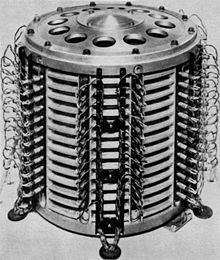磁鼓存儲器
外觀

| 電腦記憶體類型 |
|---|
| 揮發性記憶體 |
| RAM |
| 發展中 |
| 歷史上 |
| 非揮發性記憶體 |
| ROM |
| 非揮發性隨機存取記憶體 |
| 早期非揮發性隨機存取記憶體 |
| 磁式 |
| 光學式 |
| 發展中 |
| 歷史上 |
磁鼓記憶體(英語:Drum memory)是一種依靠磁介質的資料儲存裝置,為20世紀50年代和60年代計算機所用記憶體的早期形式,由Gustav Tauschek於1932年在奧地利發明。磁鼓為這套機制的主要工作儲存單元,透過穿孔紙帶或者打孔卡加載、取出資料。當時許多計算機採用了這種磁鼓記憶體,以至於它們常常被叫做「鼓機」(drum machines)。不過不久之後,磁芯記憶體等其他技術取代了磁鼓器成為了主要的儲存媒體,直到最後半導體記憶體進入了儲存媒體的領域。
外部連結
[編輯]- The Story of Mel (頁面存檔備份,存於網際網路檔案館) – the classic story about one programmer's drum machine hand-coding antics: Mel Kaye.
- Librascope LGP-30 (頁面存檔備份,存於網際網路檔案館) – The drum memory computer referenced in the above story, also referenced on Librascope LGP-30.
- Librascope RPC-4000 (頁面存檔備份,存於網際網路檔案館) – Another drum memory computer referenced in the above story
- Oral history interview with Dean Babcock (頁面存檔備份,存於網際網路檔案館). Charles Babbage Institute, University of Minnesota, Minneapolis. Babcock discusses various ERA projects including Project Lime; magnetic drum designs and capabilities; the work of Sidney Rubens and William Field on magnetic drums; and ERA's interaction with the Navy during the Korean War.
